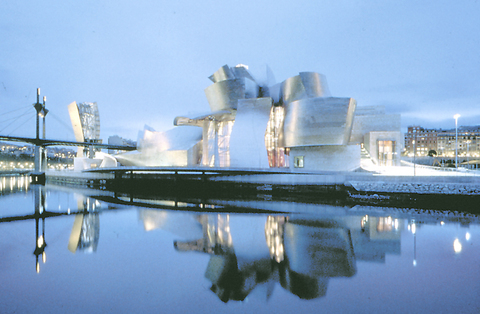The Taipei Fine Arts Museum is the hot cultural spot to visit these days as the place is overflowing with exciting chatty crowds. However, if you get too impatient waiting in the long queue to view the Vivienne Westwood fashion retrospective, then sneak right past to the third floor to see two provocative, yet disparate exhibitions.
The Art of Architecture: Works by Laureates of the Pritzker Architecture Prize was jointly organized by the museum and the Taipei Architects Association. Rather than being visually imaginative, the straightforward display is didactic and orderly in presenting chronological information on the winners from 1979 to today.
The Pritzker Architecture Prize is often referred to as the Nobel prize of architecture as it is the highest award given in its field with laureates receiving a US$100,000 grant, a formal certificate and a bronze medallion. The list of Laureates is impressive and reads like a Who's Who of the world's leading architects: Luis Barragon, Norman Foster, Frank Gehry, Oscar Niemeyer who built Brasilia, Richard Meier, I.M. Pei, Robert Venturi, Tadao Ando. Surprisingly, in its 26-year history, the prize has only been awarded to one woman -- Zaha Hadid, the architect who was slated to design the Taichung branch of the Guggenheim.

PHOTOS COURTESY OF TFAM
The first Pritzker recipient in 1979 was Philip Johnson and images of his famed glass house are on view. Equal weight is given to all the laureates' work at the exhibition. Large folding partitions contain photo blowups of world-renowned buil-dings, while small models are interspersed throughout the exhibition space. In addition, there is a highly informative reading area that contains architecture books installed on waist-level platforms. Unfortunately, there is no place to sit as this is part of the passageway, making it uncomfortable to linger and leisurely browse through the chained-up coffee table books. To the exhibition's detriment, the presentation is hard edged and not very comfy or user-friendly, which has become a recent trend in museum-based art shows.
The other exhibition is entitled The Movement of the Bamboo Stool -- A Memorial Exhibition of Lii Jiin-shiow (
The bamboo stool symbolizes the humbleness and traditional character of her life. She wasn't a diva trying to loom large on the art stage; she chose to live a modest ordinary life, raising a child, while continuing to paint and draw. Her sketches were personal reflections of an unassuming life.

Lii constantly painted and sketched her environment and was an adept draftsperson displaying great sensitivity to line and form. The exhibition is in six sections that chronologically mark her artistic journey. Before she moved to Paris she embraced Impressionist and Cubist styles.
While in Paris (1983 to 1986), Lii explored painting on transparent surfaces. Upon returning to Chiayi and Tainan she painted and drew trees as a metaphor for the vast universe.
Her later works were influenced by her Taiwanese calli-graphy teachers and her traditional French art education; yet, she painted what was ultimately the most important subject to her -- her family.
Exhibition details:
What: The Art of Architecture (to Dec. 4); and The Movement of the Bamboo Stool
Where: Taipei Fine Arts Museum,181, Zhongshan North Road, Sec 3, Taipei
(
Telephone: (02) 2595 7656
When: Until Dec. 4 and Nov. 27 respectively

This month the government ordered a one-year block of Xiaohongshu (小紅書) or Rednote, a Chinese social media platform with more than 3 million users in Taiwan. The government pointed to widespread fraud activity on the platform, along with cybersecurity failures. Officials said that they had reached out to the company and asked it to change. However, they received no response. The pro-China parties, the Chinese Nationalist Party (KMT) and Taiwan People’s Party (TPP), immediately swung into action, denouncing the ban as an attack on free speech. This “free speech” claim was then echoed by the People’s Republic of China (PRC),

Exceptions to the rule are sometimes revealing. For a brief few years, there was an emerging ideological split between the Democratic Progressive Party (DPP) and Chinese Nationalist Party (KMT) that appeared to be pushing the DPP in a direction that would be considered more liberal, and the KMT more conservative. In the previous column, “The KMT-DPP’s bureaucrat-led developmental state” (Dec. 11, page 12), we examined how Taiwan’s democratic system developed, and how both the two main parties largely accepted a similar consensus on how Taiwan should be run domestically and did not split along the left-right lines more familiar in

Specialty sandwiches loaded with the contents of an entire charcuterie board, overflowing with sauces, creams and all manner of creative add-ons, is perhaps one of the biggest global food trends of this year. From London to New York, lines form down the block for mortadella, burrata, pistachio and more stuffed between slices of fresh sourdough, rye or focaccia. To try the trend in Taipei, Munchies Mafia is for sure the spot — could this be the best sandwich in town? Carlos from Spain and Sergio from Mexico opened this spot just seven months ago. The two met working in the

Many people in Taiwan first learned about universal basic income (UBI) — the idea that the government should provide regular, no-strings-attached payments to each citizen — in 2019. While seeking the Democratic nomination for the 2020 US presidential election, Andrew Yang, a politician of Taiwanese descent, said that, if elected, he’d institute a UBI of US$1,000 per month to “get the economic boot off of people’s throats, allowing them to lift their heads up, breathe, and get excited for the future.” His campaign petered out, but the concept of UBI hasn’t gone away. Throughout the industrialized world, there are fears that